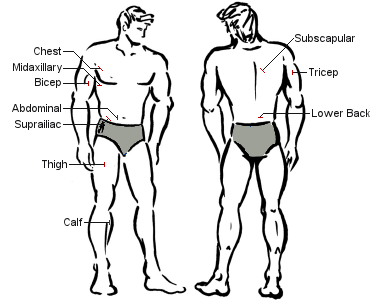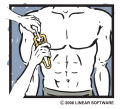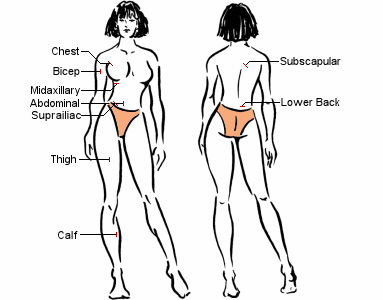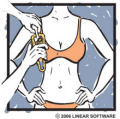Miss Candace
2010 catch up
Jan 27, 2010
Approx. Height: 5'5"
PreOp Weight: 292
Lowest Weight: 165
Current Weight: 228
Goal Weight: 160
PreOp BMI: 47
Current BMI: 38.4
Goal BMI: 26.6
BMI Weight Categories
Below - 18.5 Underweight
18.5 – 24.9 Normal
25.0 – 29.9 Overweight
30.0 and Above Obese
~*~*~*~*~*~*~*~*~*~*~*~*~*~*~*~*~*~*~*~*~*~*~*~*~*~*~*~*~*~
Goal:
Reclaim Candace
Purpose:
To get back on track, lose 79lbs in 2010, taking my vitamins/minerals on a daily basis, & getting my physical/emotional/mental hea;th back under control & in check.
How will I achieve this?:
By taking control of my physical health & scheduling in time for fitness. I am committed to working out 5 to 6 days each week. I will drink at least 64oz liquids every day, take my protein shakes, & vitamins every day.
~*~*~*~*~*~*~*~*~*~*~*~*~*~*~*~*~*~*~*~*~*~*~*~*~~*~*~*~*~*~*~
Weight Chart:
2/22/10: 228
1/25/10: 231
1/14/10: 239 (starting a new)
----------------------------------------------------------------------------------------------
6/18/08: (full on panic has set in!!) 218
8/4/06: 178 (Dont panic - just get back to the basics!)
12/15/05: 172 **:(( DAYUM those Holidays!! X(**
9/22/05: 160
4/22/05: 166.4 (1 year post op)
10/27/04: 183.5
9/15/04: 186
8/10/04: 189 (1 year since i "started my journey" & down 100 lbs.)
7/27/04: 200
6/2/04: 235
4/29/04: 248.5!!!! :O DANG!!!! thats down 15.5 - 10.5lbs!!!!
4/22/04: **SURGERY DAY!!** 264 @the hosp./ 259 @at the house
4/5/04: 260
3/3/04: 263
2/20/04: 265
1/5/04: 267.5
11/10/03: 278
11/3/03: 278.5
10/31/03: 281 (PHEW! thats better)
10/15/03: 289.6 :(( I'm going the wrong way!!!
9/25/03: 288
9/16/03: 292
8/11/03: 287
Vita Check
Jan 27, 2010
I have way more energy - Im literally zipping all over the office.
Im no longer waiting till the last minute to go potty & combining that trip w/ anything else I have to do while Im up. Im making several trips (be it to the bathroom, up the stair, or anywhere else). Furthermore, not only am i able to - i actually WANT to work out.
**ugh!!
 why didnt i put this 2 & 2 together six years ago!!!**
why didnt i put this 2 & 2 together six years ago!!!**Here are the goods:
Combined C = 1500mg
(RDA for Females 19 and older, 75 mg of Vitamin C per day)
Combined D = 600iu = 15mcg
(RDA for Infants, children and adults up to 50 years of age - 5 mcg or 200iu of Vitamin D per day)
Total A (from the multi) = 10,000iu = 6000mcg
(RDA for Females 14 and older, 700 micrograms of Vitamin A per day)
E-delta (from the multi) = 200iu= 180mg
(RDA for Males & females 14 years and older, 15 milligrams of Vitamin E per day)
Zinc (from the multi) = 15mg
(RDA for Females 19 years and older - 8 milligrams of Zinc per day)
I realize that the RDA reqs. were set in the 50's are represent the BARE MINIMUM a human being needs to ingest to sustain life. But from the looks of it - it looks like im doing pretty good.
RDA reqs:
http://www.dietbites.com/Vitamins-Minerals-Facts/vitamins.ht ml
Converstions: http://dietarysupplementdatabase.usda.nih.gov/ingredient_cal culator/help.php#q10
Starting W3
Jan 25, 2010
I implemented a daily vitamin regimine of:
ALIVE liquid multivitamin (1 cap full)
Super B complex liquid **includes biotin, b12, b6, rivoflavin -b2, niacin-b2, thiamin-b1** (1 tbs)
Biotin 100 mg (2 pills)
Super E complex 400 iu **from d-alpha, beta, delta, & gamma** (1 soft gel)
FizzC Cal-meg (1 pkt) **includes 1000mg C, 500mg Calcium (citrate/ascorbate/malate/glycinate), 250mg Magnesium (citrate/ascorbate/malate/glycinate), 200iu D3**
Chromium Picolinate 1000mg (1 pill)
Iron (ferrous sulfate) 325mg (2pills)
B12 100mg (2 pills)
A couple of observations:
1) I note that the liquid vits are much easier to ingest than the hard huge pill forms. So Im ok with liquid. Additionally, the fizzy cal-mag is MUCH EASIER to handle than trying to chop down on those huge hard calcium wafers.
 Could have sworn i broke a tooth the last time i tried to down one of those suckers.
Could have sworn i broke a tooth the last time i tried to down one of those suckers.2) Ive been taking the Iron (ferrous sulfate) 325mg (2pills) for approx 2-3 months now & recently implemented the B12 100mg (2 pills) becuase of low energy. I did not notice any distinct increase in energy. i was still tired, still going home after work & crashing for at least an hour.
However, today i noticed a HUGE BURST of energy! I was buzzing around the office today & only had to 2 cups of coffee (instead of 3 or 4). Im still a bit tired this afternoon - but all in all, I think thats a good break through.
3) Ive dropped 8 lbs, but my PT says my caloric intake(900 - 1150) is too low & i need to bump it up to 1200 - 1500 of the right kind of foods.
I feel good & Im determined to implement that third component (of daily exercise) into my routine.
Dietary tracking
Jan 24, 2010
losing weight -reducing the % of body fat - achieving better overall being health
I have to do the key components in conjunction with each other.
I have found that, in the past, i tend to focus on 1 key element & neglect the other: ie: i'll diet, but i wont exercise or take my vits.
So i finally figured out that if i want to be successful & achieve my goal this year - Ive got to do all 3 at the same time CONSISTENTLY.
I love http://www.theDailyPlate.com! Its allows me to track my food intake, log what ever exercise or activity, & keep a journal of how im feeling that day.
By tracking, Ive managed to drastically reduce my caloric intake over the course of 2 weeks. But Im still not feeling balanced. I note that my fat & carbs intake are still high & protein is still too low. I had 1 day this week where my protein went over 100g
Ive started taking my vits & mins again. Its not so bad w/ the liquid forms that I got. Plus my water intake has increased since i have to drink water when taking them.
For me, working out consistently is the hardest component to implement. I know i work out - but i do so sporadically. like a weekend worrier. So, I'm still not working out everyday like i think i should be & I know i need to change that. But i seriously lack the motivation to do so. I ALWAYS come up w/ excuses of why i cant or why im not going to go for a walk etc.
Right now - thats my biggest hurdle.
Im down 6 lbs since i re-started my journey & i feel ... okay... w/ that. Its a start :)
This weeks subject: THE SECRET OF HOW TO INTERPRET A FOOD LABEL
Jan 19, 2010
This article (from the OH home page) stuck out to me as I am currently taking a nutrition class.
As someone who is trying to lead a healthier lifestyle, I have to admit that reading the label is not something that I often do (if ever). In fact, I find it quite cumbersome - which leads to my purchasing foods that are quicker/easier to prepare, but less nutrious.
Hopefully, this will help me stay focused, throughout the year, on making the right food choices - instead of going for what's right in front of me or what's easier/cheaper (which will lead to the reduction of body fat & weight loss).
|
“You need to eat less calories, exercise more and choose healthier foods.” Does this sound familiar? Often times after leaving a doctor’s appointment and being informed about your ever rising cholesterol levels, borderline blood pressure and excessive weight gain, you leave the office with these words of wisdom. It sounds like a great idea but as you start to think about your plan of action, you often wonder what these code words mean. It seems as though you need to figure out how to decipher the code to become successful in obtaining your doctor’s wishes in improving your health, but at the same time you struggle in trying not to lose your sense of satisfaction of fulfillment when nourishing your body. Just how much do you give up to obtain a healthy lifestyle without compromising the joy you experience from eating your favorite foods? As a Registered Dietitian, I have witnessed this transition from bariatric pre-op to bariatric post op. It may be difficult, as it will take some work and effort on your part, especially in the beginning as you learn how to retrain your body into craving specific food items. Understanding food labels and knowing what to look for while grocery shopping is the starting point to your success in becoming a healthier you. Depending on your personal goals, there are specific items you should target for your individual needs. As a post bariatric patient, protein is a very important food component. It is not only is used for growth and repair of the human body, but since carbohydrates are limited due to potential dumping syndrome (such as nausea, vomiting, diarrhea), protein is also used as a source of energy. Therefore, when reading a food label, the first item you should review is the amount of protein in that product. The values will differ from various food sources, i.e. animal protein will contain a larger amount of protein than a piece of fruit or a vegetable would. This means the higher the protein, the more beneficial. |
|
|
Carbohydrates are the next important item on the food label as it provides energy for the brain and muscles. Sugar and fiber fall under the umbrella term carbohydrate. There are “good carbohydrates” that are low on the glycemic index and are high in fiber to help sustain one’s appetite and energy levels; then, there are “bad” carbohydrates that are very high on the glycemic index which do not sustain energy for long periods of time. For example, a piece of whole grain bread will contain more fiber and less sugar than a candy bar, helping to increase the length of feeling full in between meals and also helping with proper GI motility. It is very important to understand the difference between a high fiber carbohydrate source versus a high sugar carbohydrate source. | |
 |
This week's subject: % of BODY FAT
Jan 14, 2010
Understanding Your Body Fat Percentage http://www.healthchecksystems.com/bodyfat.htm
Body fat measurements and the measuring tape are recognized as superior methods for measuring "weight loss". When one declares that they want to "lose weight", what they often mean is that they want to lose fat. So, now that you've had your body fat percentage measured, what does the number really mean? 
First, your body fat percentage is simply the percentage of fat your body contains. If you are 150 pounds and 10% fat, it means that your body consists of 15 pounds fat and 135 pounds lean body mass (bone, muscle, organ tissue, blood and everything else).
A certain amount of fat is essential to bodily functions. Fat regulates body temperature, cushions and insulates organs and tissues and is the main form of the body's energy storage. The following table describes body fat ranges and their associated categories:
*General Body Fat Percentage Categories
| Classification | Women (% fat) | Men (% fat) |
|---|---|---|
| Essential Fat | 10-12% | 2-4% |
| Athletes | 14-20% | 6-13% |
| Fitness | 21-24% | 14-17% |
| Acceptable | 25-31% | 18-25% |
| Obese | 32% plus | 25% plus |
Knowing your body fat percentage can also help you determine if your weight loss goals are realistic. Remember, weight loss doesn't always mean fat loss. For example:
Let's say you're a 130# woman with 23% body fat, and you goal is to "lose 20 pounds":
Initial body fat: 130# x 0.23 fat = 30 # body fat
Lean body mass: 130# total - 30# fat = 100# lean body mass (bones, organs and all else)
Goal: 130# - 20# = 110 pounds
As you can see, the goal of losing 20 pounds is not realistic or healthy. At 110 pounds, this woman still requires 100# of lean body mass (bones, organs, etc.), but would only be carrying 10#, or only 9% body fat. From the chart above, you can see that this is a dangerously low percentage.
A better goal might be for the woman to reduce her body fat from 23% to 18%. In this case:
130# x 0.18 = 23 # body fat
100# lean body mass + 23 # = 123# goal weight
So, for this individual to achieve a lean, but healthy 18% fat, she would need to lose only 7 pounds of fat, reducing her weight from her current 130 pounds to 123 pounds. Losing more than 7 pounds means losing lean body mass (usually metabolically-active muscle tissue), which is clearly not desirable.
So before you decide that you need to "lose weight", remember to consider that "weight" consists of both lean body mass and body fat. Try to keep your weight loss goals realistic, and remember, keep the calorie-burning muscle, and lose only the fat.
To help reinforce this practice/habit, I found the following data & body fat calculator at
Online Body Fat Calculator for Men and Women.
However, to ensure you receive accurate data, you will have to visit the site at http://www.linear-software.com/online.html to use the calculator tool as not all of the fields are importing on this end properly.
 Body Fat Caliper Measurement Sites - Men
Body Fat Caliper Measurement Sites - Men
Chest - Diagonal fold, midway between upper armpit and nipple
Midaxillary - Horizontal fold, directly below armpit
Bicep - Vertical fold, halfway between shoulder and elbow, directly on bicep
Abdominal - Vertical fold, one inch to the right of navel
Suprailiac - Diagonal fold, directly above iliac crest
Thigh- Vertical fold, midway between knee cap and top of thigh
Calf - Vertical fold, inside of leg on largest part of calf
Subscapular - Diagonal fold, directly below shoulder blade
Tricep - Vertical fold, midway between elbow and shoulder
Lower Back - Horizontal fold, directly over the kidneys, and 2 inches to the right of spine
 Click here for images for body fat calculator measurement sites
Click here for images for body fat calculator measurement sites
![]()
Body Fat Caliper Procedures1
1.) All measurement should be made on the right side of the body
2.) Caliper should be placed 1 cm away from thumb and finger, perpendicular to skinfold, and halfway between crest and base of fold
3.) Pinch should be maintained while reading the caliper
4.) Wait 1 to 2 s (and not longer) before reading caliper
5.) Take duplicate measures at each site and retest if duplicate measurements are not within 1 to 2 mm
6.) Rotate through measurement sites or allow time for skin to regain normal texture and thickness
![]()
1American College of Sports Medicine. ACSM's Guidelines For Exercise Testing and Prescription. 6th Edition. USA, Lippincott Williams & Wilkins 2000;65.

Chest - Diagonal fold, one third of the way between upper armpit and nipple
Midaxillary - Horizontal fold, directly below armpit
Bicep - Vertical fold, halfway between shoulder and elbow, directly on bicep
Abdominal - Vertical fold, one inch to the right of navel
Suprailiac - Diagonal fold, directly above iliac crest
Thigh- Vertical fold, midway between knee cap and top of thigh
Calf - Vertical fold, inside of leg on largest part of calf
Subscapular - Diagonal fold, directly below shoulder blade
Tricep - Vertical fold, midway between elbow and shoulder
Lower Back - Horizontal fold, directly over the kidneys, and 2 inches to the right of spine
 Click here for images for body fat calculator measurement sites
Click here for images for body fat calculator measurement sitesBody Fat Caliper Procedures1
1.) All measurement should be made on the right side of the body
2.) Caliper should be placed 1 cm away from the thumb and finger, perpendicular to the skinfold, and halfway between the crest and the base of the fold
3.) Pinch should be maintained while reading the caliper
4.) Wait 1 to 2 s (and not longer) before reading caliper
5.) Take duplicate measures at each site and retest if duplicate measurements are not within 1 to 2 mm
6.) Rotate through measurement sites or allow time for skin to regain normal texture and thickness
1American College of Sports Medicine. ACSM's Guidelines For Exercise Testing and Prescription. 6th Edition. USA, Lippincott Williams & Wilkins 2000;65.
Here's to conquering body fat!
2010 & still fighting the battle
Jan 14, 2010

Well, here we are, 2010 & I am still trying to get back down to 160. Since i last checked in (in 2008), i managed to "find" approx. 20 lbs. & I'm struggling to get back down.
It seems that every year i reach a crisis point with my weight & scream to the heavens BACK TO BASICS but MAN how i wish i could learn my lesson & just reach & maintain my goal of 160... even 180... but ideally 160.
So I'm back to using all of my tools. The 5dpt (love it), online tracking here, on thedailyplate.com & on mapmywalk.com (that's a great tool!!) in hopes that actually SEEING what I'm consuming, how that's being absorbed, what my physical activity is will help snap me out of it & get me where i want to be.
My last post (in 2008) revolved around the subject of how important taking our vits are (love you Anita!!!). I stayed on that soap box for about a month & then fell off as my weight creeped back up. Moving forward, I'm really going to try to break that habit.
However, that made me realize that I don't know a lot about nutrition & how my body reacts to the food choices i make. Truth be told, nutrition is kind of a guessing game for me & I believe that is a large part of the battle - KNOWLEDGE. So I figured I'd use this forum to post about topics that I find challenging or really didn't know a lot about or completely understand. For one, it will serve as a personal reminder & two, perhaps my research will help some of you with your battle (I cant be the only one who doesnt quite get it).
Best of luck to us all.
